Creeping bellflower is a common edible weed in yards and gardens. It spreads quickly, but thankfully, it's edible and tastes good. In this post I'll tell you all I know about harvesting and cooking the plant.
Creeping Bellflower is Invasive
Creeping bellflower, also known as rampion bellflower, like a lot of edible wild plants that I like to eat, is a weed. A transplant from Europe and Siberia, it was apparently popular as a garden plant (like many weeds in the United States) and, as weeds will do, it rapidly spread from gardens to yards, to forests and fields.
Now, the plant is widespread across the United States--bad news for native plants which it can crowd out and out-compete. It's a common yard weed in Wisconsin and Minnesota where I forage.
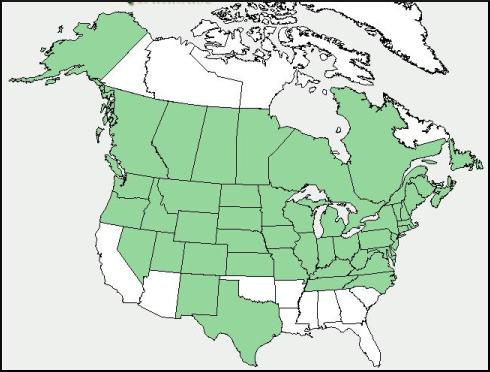
Bellflower Is Edible
The good news, is that you can eat it, and you should--as much as you can find. Like a lot of other greens you might forage, creeping bellflower is better cooked than it is raw, in my opinion.
The leaves, in their fresh state, even when very young, are a bit chewy, and the midrib sticks out a bit. You could technically probably hide a few leaves in a salad, but I hardly see the point when it's so much better as a pot herb (cooked).
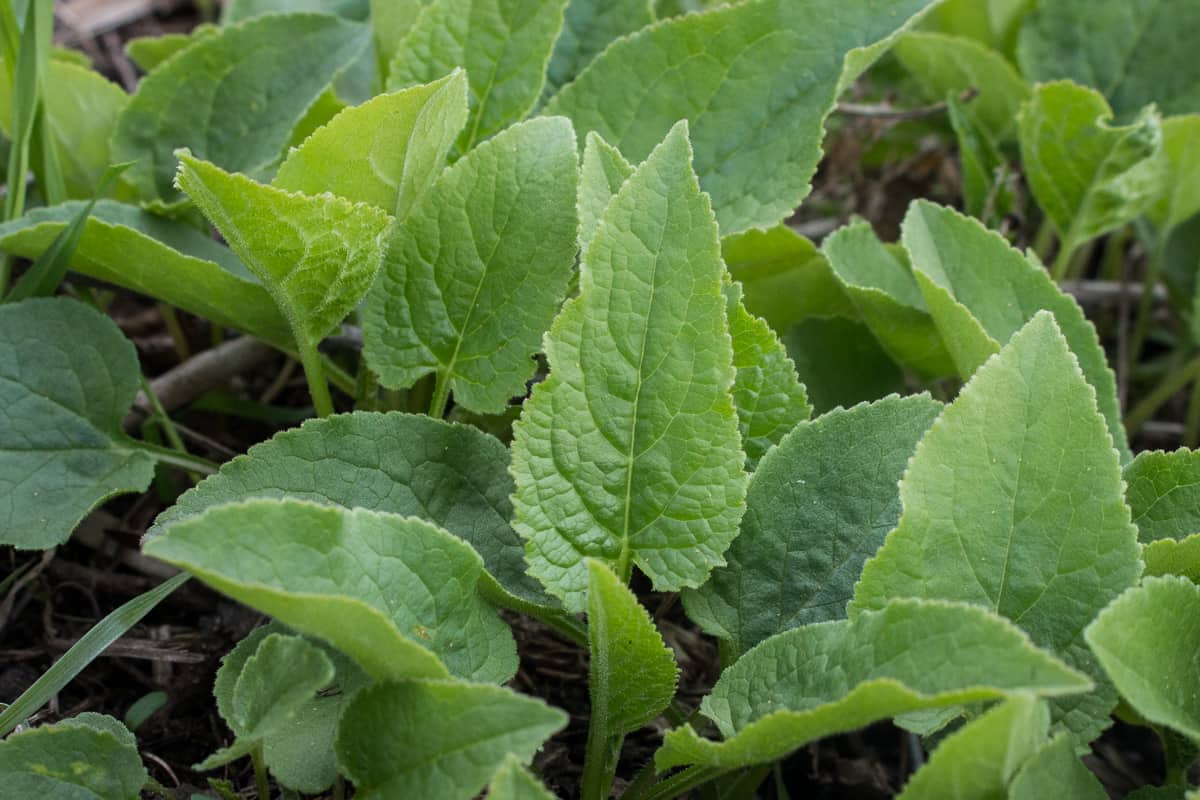
Cooking Creeping Bellflower
As far as harvesting, it's easy. Just clip them like any other greens and add to the basket. One thing to mention is that I only harvest the basal leaves of the plant, which, if you're unlucky enough to have them in your yard, will probably look like a reasonably thick carpet of greens.
The good news is unlike a lot of other greens, ground elder for example, creeping bellflower stays relatively the same throughout the growing season--it's not going to be horribly tough (or comparatively tender) throughout the season. I do only harvest the basal leaves though, as leaves growing up the flower stalks are relatively small and north worth mentioning.
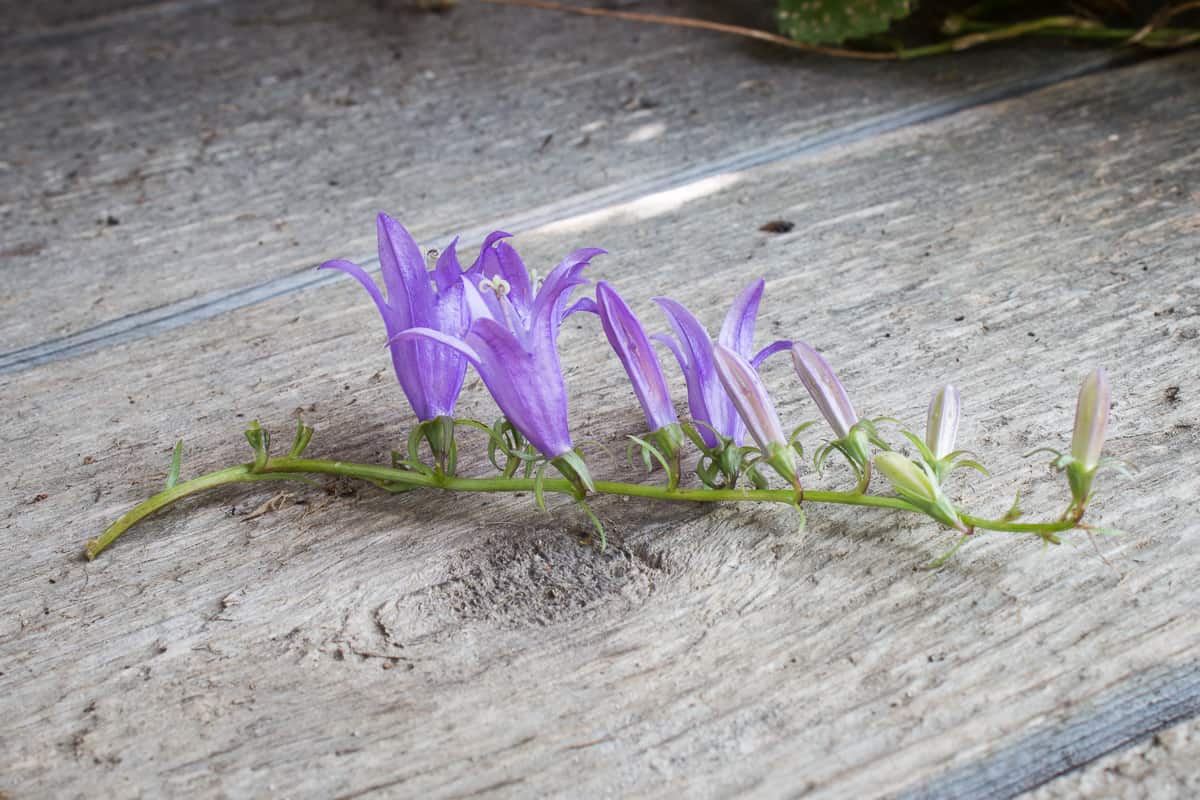
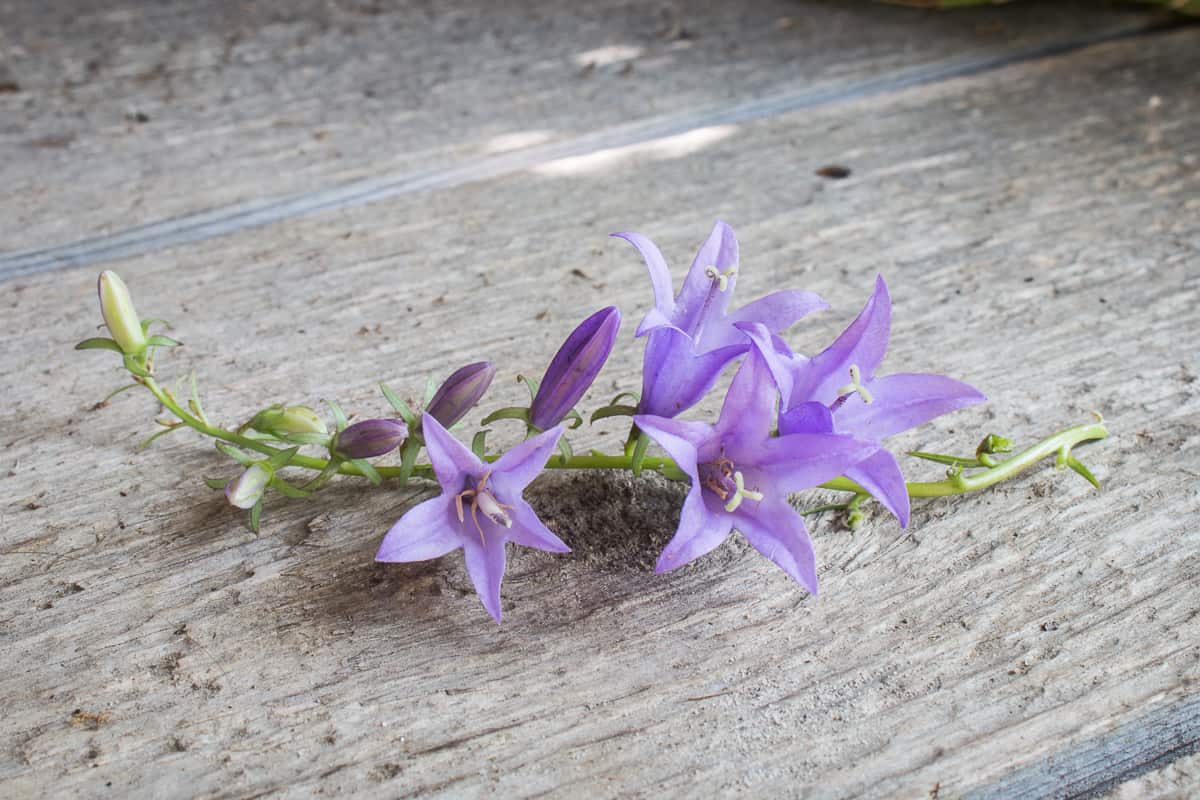
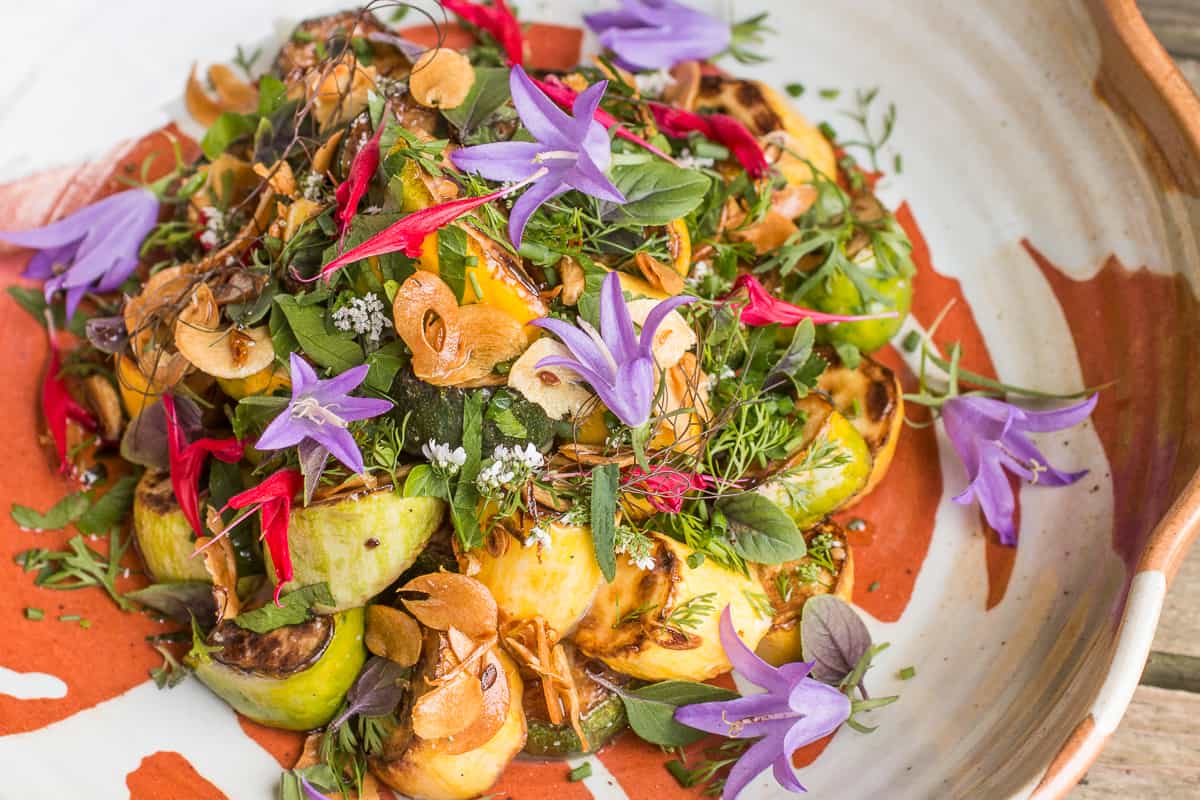
The flavor is nothing fine, and just fine, it's not bitter, not incredibly sweet, not really anything too out of the ordinary. The good part, is that means it's a fine addition to a pan of wilted greens, and it will fade into the background just fine without overtaking other flavors. It's a good green for the table--typically I use it in a blend with other greens like Virginia waterleaf (hydrophyllum virginiana), violets, and mitsuba (Cryptotaenia canadensis).
 Flowers
Flowers
Besides cooking the basal leaves, the only other thing really worth mentioning is the purple bell-shaped flowers--they're a deep beautiful blue, and stand up well to an overnight stay in the fridge. Add some to a salad--they'll make a good conversation piece as well as a segue into different yard weeds you can eat.
Creeping Bellflower Roots
The tubers of related plants are harvested in France and eaten as a vegetable. Apparently they're quite good. C. rapunculoides should have edible roots too, but I haven't tried them yet, so you're on your own there.

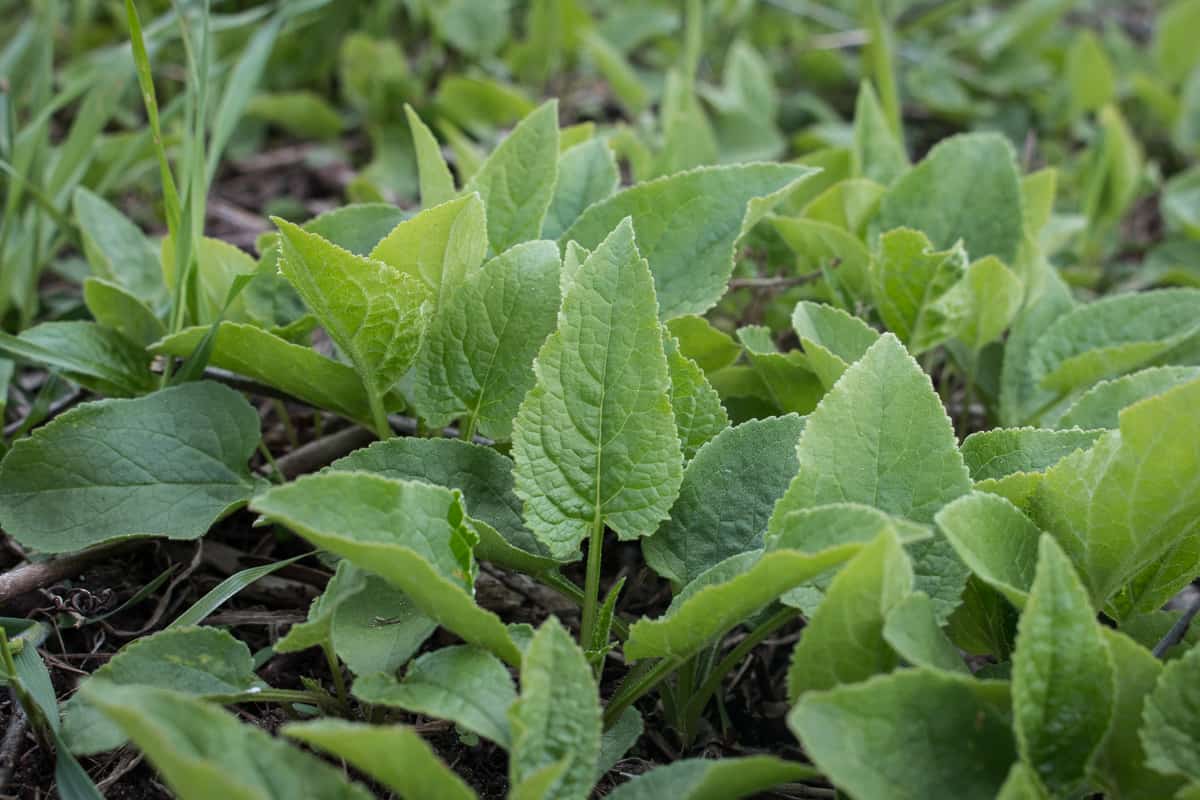
 Flowers
Flowers
Luana
Hi! Just wondering if they are still edible later in the summer, as I didn’t learn of this till now (July)
Alan Bergo
It’s technically edible, but it depends on what part of the plant we’re discussing. Leaves are edible when tender and young before flowering. Flowers are edible. Roots are dug in the spring or fall as food.
Janene
I love creeping bellflower! It’s the first thing ready in my garden. Yes it’s a weed and invasive. So I go to a spot where I don’t want it, pull about 15 plants, cut off the roots so I don’t get dirt in the batch. I then rinse and pull off the leaves so the rib stays on the stem if possible. Then into a pot with a little water, olive oil, salt and a diced garlic clove. When the water is mostly gone, time to serve and eat!
Alan Bergo
Thanks Janene, I keep a small patch on my property that’s not allowed to go to seed.
Sara
I have millions of these invasives in my yard, but HAPPILY they provide TONS of salad for our chickens who eat them voraciously. Those darn tuber roots are like sideways carrots & make it nearly impossible to eradicate, and they keep growing leaves eternally. So you will NEVER EVER run out of chicken “salad!” It’s even WORSE than bindweed! With that & comfrey your chickens will have free food all summer. BUT if you don’t have it, NEVER buy or plant bellflower, it’ll take over everything!!
A.F.
I've eaten the stems (basal, not flower) raw just now (mid spring) from what seems like overwintered plants. They are really nice. Thick, juicy, crunchy and mildly sweet. I think I'll be adding them pemanently to my early spring garden greens menu! Looking forward to trying a bigger bunch pan fried with some garlic.
I have dug the tubers before and eaten them raw. They taste like a very mild, earthy carrot. Haven't tried cooking them yet.
DB
I don't want to eat it, I want to kill it!
Alan Bergo
You can do both.
Debi Ulrey-Crosby
I have lots of this horrible weed as well. I'm going to try eating some. Maybe then it will just disappear. You know, kind of like other things do once they have a real value...they disappear. I would not be sad if it disappeared in my yard. Every spring I feel a little guilty about ripping out the flowering stems because the bees, especially bumble bees (my absolute favorite), love the flowers. But I try to make up for it by planting other flowers.
Alan Bergo
Hi Debi. Yes this plant is really invasive. You have to dig the roots out and go deep to really make a difference.
Ingrid
Wonder if anyone has tried making tea with the flowers 🙂
Alan Bergo
They're not worth using, pretty but no flavor.
Amanda
What are your thoughts on drying and making tea from the flowers themselves?
Alan Bergo
Hi Amanda, the flowers aren't aromatic or interesting enough dried imo.
Cathy
I have dug out what I can, roots & tubers, from a patch in a front garden. Laid down a large piece of landscape material ,covered with bark mulch. Fingers crossed that in the spring of 2026 I won't be working at this project again.
Alan Bergo
Good luck. It can be a real pain as those pesky roots go deep.
Lise Gray
Have made tea with it! 🥰
Rachel
Yay! Making modified gluten-free green cakes with a Korean flavor tonite to try them out and welcome a new weed to the table. Thank you for inspiring.
Alan Bergo
Hey that’s great. I’m actually going to go dig Bellflower roots finally next week and I’m so excited. Have fun.
Lou Helf
Did you try the roots? Also, I'm so excited to learn about this because I have SO MUCH creeping bellflower in my yard.
Alan Bergo
Yes! Thanks for the reminder. Unfortunately I wasn't able to dig them myself, so the roots my friend gave me were pretty thin. But, even at the thickness of a pen or your pinky they're pretty good. Very mild, not bitter, texture of a carrot with thicker skin, mild flavor that I mild describe as slightly artichoke-y, the way that salsify roots and scorzanera are. Boil clean, gently scrubbed roots for 2-3 minutes or until just tender, cut into 1/2 inch pieces, a little melted butter and a pinch of salt and they were pretty darn good for a first shot. I'll probably try them in soup next.
Julie Weisenhorn
Creeping bell flower is becoming public enemy #1 in gardens and natural areas. It spreads by seeds and rhizomes. So managing it to prevent it from spreading beyond your yards and gardens is important. Remove stems before they set seed and keep plants in bounds by removing the rhizomes around the perimeter of the plant . I'm glad to hear it has some edibility factors because there is a lot of it around!
Alan Bergo
Yes I've seen it in large colonies. Definitely a tricky one to get rid of, but there's much worse, too. My new house has ground elder 🙁
R. P.
Ground elder is tasty, too!
Alan Bergo
Yep! I went over them a little this spring in my post on Ground Elder.
Desiree
I've eaten the roots- they are best in spring before they flower. To me, they are relatively bland- not bitter- not anything, really. They do well mixed in with other vegetables, such as in a stir-fry. I wouldn't bother, but creeping bell flower is abundant in my yard, and I'm assuming I'm getting some nutrition from the plant.
Alan Bergo
Thanks Desiree.
Shawn Scepan
We’ve got some of this in the yard too! Just read that the roots have a historical spot on a traditional Korean table. After a blanch and a sautée with simple traditional flavors (ses oil, salt, sugar, garlic) it’s slight bitterness is welcomed, even among kiddos… kind of a ginseng-y flavor. Thank you for the wealth chef.
Alan Bergo
Super cool Shawn. I haven't been able to have the roots yet, I think I need to find a larger species or get them in softer ground. Another question to ask Sam as they're supposed to be really good.
Kari Snyder
I’ve read that the tubers are edible, too. Have you tried them?
Alan Bergo
Nope. Haven't tried them. I do enjoy the greens cooked though. Just ate some last night.